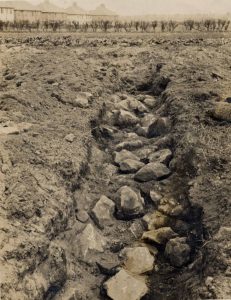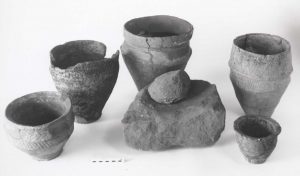A History Of Warrington In 10 1/2 Objects: Grappenhall Burial Urn
Collections Officer Craig Sherwood presents the third episode in our new series of podcasts, looking at 10 (and a half) objects from Warrington Museum’s Collection that tell the history of the town.
Listen using the player below, or scroll down to read the full transcript.
Hello and welcome to the third episode of the podcast “A History of Warrington in 10 and a Half objects”. I am Craig Sherwood, the Collections Officer for Warrington Museum & Art Gallery.
The village of Grappenhall, near Warrington, is first mentioned in the Domesday book of 1086 where it is referred to as ‘Gropenhale’ meaning ‘a piece of flat land by the side of a river’. Today Grappenhall remains rural in character with a mixture of Georgian villas and neat rows of 18th Century and Edwardian cottages nestling alongside newer houses which were built in the 1930s. It was this early 20th century expansion of the village that led to the discovery of the object we are discussing today as in 1930 Mr Massey of ‘Cranford’ in Grappenhall visited Warrington Museum to report that a group of unusual sandstone blocks lying on a bed of white sand had been exposed in a field to the North of his house.
Staff from the museum decided to investigate and digging a little way underneath found a badly broken pottery urn containing cremated human remains underneath one of the blocks. What Mr Massey had found was not just a group of unusual blocks of stone but part a Bronze Age cairn and with it a pottery urn containing the remains of one of the first occupants of the Warrington area. Mr Massey had stumbled upon a Bronze Age burial ground.
Object Number 3, a Bronze Age burial urn made of smoke-fired terracotta, between 3900 and 3000 years old, found in Grappenhall near Warrington.

One of the Grappenhall Bronze Age burial urns
What is it with museums and pots? Whether stoneware, earthenware or porcelain there are pots over here … pots over there. POTS. Pots, pots, pots, pots, pots, pots, pots. I do hope you’re writing this all down.
Human history is made and sometimes even written more in pottery than anything else whether you are talking about a 5,000-year-old clay tablet with writing from Southern Iraq, an Ancient Greek vase depicting battling heroes, a piece of Roman Samian ware, a Georgian coffee pot, a Charles and Di commemorative plate or even your favourite chipped mug that you jealously guard with your life and which somewhat dubiously proclaims that you are the “World’s Best Dad”. People have had a relationship with pottery for thousands of years and it is a relationship that does not seem likely to end any time soon.
In archaeological terms pottery is quite simply the most common and important type of artifact to survive the passage of time – it is an incredibly durable material and individual shards of pottery and even the occasional complete pot can survive for thousands of years. Lacking other evidence entire prehistoric cultures are named after the type or shape of the pottery they produced and even today it remains the easiest way to identify their different sites. More recently archaeologists have developed technology to recognise different types of pottery from the chemistry of even the tiniest of shards.
The World’s first pots were probably made in Asia around 20,000 years ago but the first people to make pottery in Britain were probably Neolithic farmers around 5,000 years ago. You are only going to make pottery if you are going to stay in one place all year round because it’s an awkward thing to carry around with you and it is only through farming that people were able to stay in one place and build up a surplus of food to survive on over the winter. By the Bronze Age some of these hand-made pots were being used for storing and cooking food, but it is their use as containers for cremation burials that has ensured that some of these early vessels have survived more or less complete over thousands of years.
I am standing in front of the Grappenhall burial urn right now and it is a large terracotta pot around 20 centimetres tall and shaped somewhat like a large beaker with a collar with geometric decoration at the top. It has obviously been hand made using coarse clay and then fired in an open bonfire – a process that, combined with the fact that this vessel has been reassembled from fragments, has resulted in a mottled colouration. Like other ancient pots fired in open bonfires the pot is relatively weak by modern standards as Bronze age potters were not able to create fires that reached the high temperatures of a modern kiln.
In Britain, the so-called Bronze Age during which people first started to produce tools from alloys of copper and tin stretches from around 4,500 years ago to 2,800 years ago but it is important to remember that the technology used to make Bronze tools was developed in different places at different times. In parts of Europe people were working Bronze around 5,300 years ago but as with farming this new technology took over a thousand years to catch on in Britain. It is also worth pointing out that the transition between the preceding Stone Age and the Bronze Age is not as clearly defined as we like to think. People had already started mining and using copper towards the end of the Stone Age and people continued to use flint tools and arrowheads well into the Bronze Age. This is probably because metal tools were still rare and high-status objects, but I like to think that this was due to the Bronze Age equivalent of hipsters that tried hard to be different by using stone tools far longer than everybody else and rejecting the new-fangled Bronze as “too mainstream”.
The first metalworkers to arrive in Britain were the so-called Beaker people who arrived around 4,500 years ago and are named after the bell-shaped pottery vessels they produced. These were the second population of farmers to arrive in Britain from Europe after the Neolithic settlers a thousand years earlier. If these Beaker people ever settled in the Warrington area, they have left no sign of their presence, although their descendants have left a great deal of evidence of their activities in the region including the burials at Grappenhall.
And so, we return to the broken urn found underneath some sandstone blocks that Mr Massey spotted in a field over 90 years ago. The blocks covering the urn turned out to be the remains of a mound known as round barrow or a tumulus which was a common method of honouring the dead during the Bronze Age. These distinctive circular burial sites were created by digging a circular ditch and then placing earth and stones and sand in a mound over a burial or cremation. Over 140 of these barrows have been found in Cheshire and around 6 of them are concentrated in the Warrington area focused on the modern communities of Grappenhall, Winwick and Croft.
Although a second smaller barrow was discovered in Grappenhall in December 1931 the first larger barrow was not excavated until January 1934 when it was investigated by a group from the Warrington Museum led by the archaeologist Albert Leslie Armstrong. They discovered a stone-built cairn around 11 metres in diameter ringed with large stones with a single gap in them, which possibly formed an entrance. The main burial had been placed in a central stone cist or stone-lined pit sealed with a slab, while several secondary burials had been inserted into small pits dug into the barrow later. Both this and the second barrow were surrounded by a flat cemetery or urnfield consisting of several cremations which had been placed in more pits.

The excavation of the second smaller barrow in March 1931
The publicity attracted by the excavations brought in several reports of other Bronze Age finds that had been made in the village and even evidence of a third round-barrow which may have been destroyed by building work 7 years earlier. Unfortunately, the finds in the museum are the only remaining evidence of Grappenhall barrows today but the fact that two or perhaps even three barrows were discovered in a relatively small area indicate that at one point this may have been a site of some importance.
So why were several round barrows found together? The most likely explanation is that Mr Massey may have stumbled upon part of a sacred Bronze Age site. Round barrows such as those found in Grappenhall were most often placed on the edges of existing Bronze Age settlements, perhaps signifying a division between the land of the living and the land of the dead. This unknown Bronze Age settlement may even have been quite important as the large number of Bronze tools which have been found along the banks of the river between Liverpool and the Warrington area indicate this may have been a stopping place for travellers, perhaps even traders who had crossed from Ireland to exchange goods in what is now Yorkshire and the Midlands. There is some evidence that the copper mines at Great Orme and Alderley Edge were flourishing at this time and this may even have led to a shift in wealth away from Southern England towards the Northwest. This is one of the few periods when the area may have been becoming economically dominant in Britain – the first instance of a Northern Powerhouse if you like.
But what can these Bronze Age urn burials tell us about changing attitudes to the dead. In our last episode we discussed the end of the preceding Stone Age, a period known as the Neolithic which lasted from around 6,000 to 4,500 years ago. Several different types of Neolithic burials have been found in Britain – from the long barrows of Southern and Eastern England to the Cairns and passage graves of Ireland – but they do share some common characteristics. Firstly, they are large man-made monuments which would have reflect the move to a settled agricultural population who had started to put down roots. Secondly, each burial contains the remains of several people. There is evidence that bones, particularly skulls, were often later removed from Neolithic tombs after burial for some reason and it is likely that the larger tombs were periodically sorted and cleaned out for reuse.
We do not know why certain Neolithic people were selected to be buried in tombs and other people were not although it is reasonable to suggest that it maybe had something to do with some combination of their age, gender, wealth, status or even the way that they died. What we do know is that not everybody got a burial. Even accounting for the much smaller Stone Age population of Britain and the fact that many burials must have been lost over the millennia there are not nearly enough tombs to go around. Archaeologists have suggested that most people of this period were excarnated – a misleadingly pleasant term which means leaving the body in the open air for animals to scavenge the flesh. Bones do not last exceptionally long in the open and this may therefore explain the lack of burials. Some archaeologists have even suggested that the people found buried in Neolithic tombs are merely those whose bones survived exposure and remained to be collected for burial. This proves two things – firstly that we still know extraordinarily little about Neolithic burial practices and secondly that some Archaeologists really, really need to lighten up.
What is interesting about the Grappenhall burials and the burial urns found within is that unlike the mass burials and scattered bones of their Stone Age ancestors the people of the Bronze Age had obviously began to focus on their individual rather than their collective dead. By cremating their deceased, placing the remains in a pottery vessel in a stone coffin and then raising a mound over the top the living Bronze Age people were signifying the status or position in society of their loved ones, as opposed to honouring their ancestors as a group. This might indicate a growing concern with people’s family and personal history and a move away from the supernatural power of those that had come before.
Towards the middle of the Bronze Age this practice developed further, and people began to bury their dead with greater amounts of grave goods such as beads, weapons, and jewellery. This is probably because these Bronze Age people were more settled than their ancestors and had started to acquire more belongings such as high-quality metal tools, ornaments, and yes, highly decorated pots. This may help explain why Bronze Age burials are so special to many Archaeologists because these personal possessions make the deceased someone, they are more able to relate to. It is easier to feel like you are getting to know the individual being excavated in a Bronze Age burial, how they were viewed by their peers and loved ones and to guess at their position in the society in which they lived.
Whatever the explanation for this shifting attitude round 3,000 years ago attitudes seem to have changed again. People stopped building round barrows, although as with the tumulus at Grappenhall people continued to insert new burials in existing mounds. The people of the later Bronze Age and following Iron Age continued to cremate their dead but rather than building barrows they started using flat areas of ground known as urnfields in which ashes were deposited in shallow pits. The fact that the Grappenhall site shows evidence of all these different types of burial implies this now vanished sacred Bronze Age landscape may have been in use for some significant length of time.

The burial urns, a saddle quern and smaller pottery vessel all found at Grappenhall in the 1930s.
There is one last factor that is worth pointing out about Bronze Age burial urns like the one found in Grappenhall. Many Early and Middle Bronze Age burial urns were often found upside down and it is probable that these were upturned over the cremated remains or even sealed using a long-since disintegrated pieces of cloth or leather which stretched over the top and then tied in place. The fact that so many of these vessels which may have been intended to sit inverted in a burial mound for eternity are now displayed in museums in what conveniently – for us at least – looks like the right way up implies that with these ancient burial urns, as with so many aspects of Prehistoric culture we might just need to try looking at them in a different way.
We are staying with pottery for our next object but this time it is not a pot or even any other kind of vessel. Instead, we are finally moving from prehistory into history and looking at a rare pottery mask and what it might be able to tell us about Warrington during the Roman period.
If you would like to find out more about the Grappenhall Urns and other items in the museum collection, please check out our website at wmag.culturewarrington.org where you can also find a complete transcript of this episode. The music in this podcast is ‘Alone in the Museum’ by Edwin Montgomery used here under an Attribution-Non-Commercial-No Derivatives International License
Further reading:
- Anderson, Sue ‘Burial Practices by Period’ in Spoilheap Archaeology
- Archaeological Surveys Ltd (1976), The Archaeology of Warrington’s Past
- Cheshire Archaeology, Revealing Cheshire’s Past: Barrows to Bog Bodies
- Crosby, Alan (2002) ‘A History of Warrington‘
- Tatton, Harriet (2016) ‘Were Bronze Age Burial Practices All That Different?’



